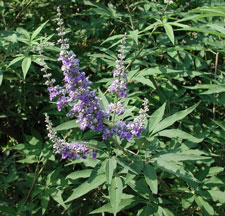Resource Library
Plant of the Week: Chaste Tree
The University of Arkansas System Division of Agriculture does not promote, support or recommend plants featured in "Plant of the Week." Please consult your local Extension office for plants suitable for your region.
Plant of the Week
Chaste Tree
Latin: Vitex agnus-castus

The summertime scene is dominated by green with most flowering trees - other than the warm shades of crapemyrtles - just vague memories of the distant spring season. But the chaste tree takes on the heat and humidity of summer by providing a cooling splash of blue to the midsummer scene.
Though not common, chaste tree (Vitex agnus-castus), is a widely adapted small tree or large shrub growing 10 to 18 feet tall. It grows with wide spreading branches and is usually wider than it is tall. It is one of the few winter-hardy woody members of the verbena family.
Chaste tree is native to Western Asia and southern Europe. It is usually multi-trunked with distinctive palmately compound leaves with five to seven leaflets. The leaves resemble those of marijuana; occasionally the plant is called hemp tree for that reason. When crushed, the leaves have a distinctive aroma.
Blue to violet spikes of flowers are produced early- to mid-summer on the ends of new shoots. The spikes are branched with the entire inflorescence being up to a foot long and wide. If plants continue to grow they will continue to flower on and off during the summer. White and pink flowered forms are available, but the darker colored selections stand out better in the summer landscape.
After flowering, the bloom spikes are covered with peppercorn-sized rounded fruits that line the old bloom stock. It is from these fruit that chaste tree derives its common name.
The Greeks believed an extract from the fruits calmed sexual passions and cured various female ailments. This contention, first written down in the 4th century BC by Hippocrates, was copied through the ages by various herbalists until German doctors began conducting clinical trials with it during the 1930s. They found it was effective, though slow acting, at relieving symptoms of PMS and other specific female conditions.
Summer flowering trees such as this make good additions to the summer shrub border, for screening areas or as lawn specimens. Their size can be controlled easily by late winter pruning to keep the plant to a more modest stature. Chaste trees flower on new growth so hard pruning does not disrupt flowering. It is a favorite of bees, butterflies and hummingbirds, so put it where it can be seen from patios and decks. Many beekeepers seek out chaste tree as a summertime nectar source.
Chaste tree is a tough, drought-resistant plant hardy from zones 6 to 9. It needs full sun to flower but is not particular about soil type. Like most plants, it grows larger in better soils with some attention paid to watering and fertilization. Other than the possibility of root rot in heavy clay soils, chaste tree is not bothered by insects or disease.
By: Gerald Klingaman, retired
Extension Horticulturist - Ornamentals
Extension News - August 17, 2007
The University of Arkansas System Division of Agriculture does not maintain lists of retail outlets where these plants can be purchased. Please check your local nursery or other retail outlets to ask about the availability of these plants for your growing area.